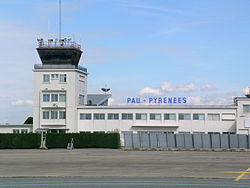Pau Pyrenees Airport
| Aéroport de Pau-Pyrénées Base militaire de Pau-Uzein |
|
|---|---|

|
|
| Characteristics | |
| ICAO code | LFBP |
| IATA code | PUF |
| Coordinates | |
| Height above MSL | 187 m (614 ft ) |
| Transport links | |
| Distance from the city center | 7 km north of Pau |
| Street | D 716 |
| Basic data | |
| operator | CCI Pau |
| surface | 650 ha |
| Terminals | 1 |
| Passengers | 602,322 (2019) |
| Air freight | 732 t (2019) |
| Flight movements |
9,647 (2019) |
| Start-and runway | |
| 13/31 | 2500 m × 45 m asphalt |
The Aéroport de Pau-Pyrénées is a civil-military French airport , it is located in the commune of Uzein in the Pyrénées-Atlantiques department . The Pau Chamber of Commerce and Industry is responsible for the civil airport . The airport is open around the clock. Up to 1,000,000 passengers can be handled annually on 10,000 m². In addition, the French Army Aviation légère de l'armée de Terre (ALAT) use the airport as a military airfield , Base militaire de Pau-Uzein .
history
The origins of today's airport date back to 1909, the Wright brothers and later Louis Blériot also flew from here. Since then, the area has been used continuously for aviation, until today also for military purposes, initially by the air forces .
The first terminal building for civil use was built in 1948 and the first paved runway was built around the same time. The current civil area was built in 1984, and a new terminal with a capacity of 1 million passengers per year was added in 2002.
The military part, last designated by the French Air Force as Base aérienne 119 Pau , was last used by the Armée de l'air as a helicopter base and was handed over to the Army Aviation in the early 1970s .
Since then, they have continued to use the airfield as a helicopter base, the unit located here has been known as the 5th combat helicopter regiment, 5e régiment d'hélicoptères de combat (5e RHC) since 1977 . Since 1997, some of the special forces that are subordinate to the Commandement des opérations spéciales (COS) have also been stationed here . It was initially in battalion strength the Détachement ALAT des opérations spéciales (DAOS), which was enlarged in 2009 to a regiment, the 4e régiment d'hélicoptères des forces spéciales (4e RHFS).
In 2007 the first Tiger arrived at the 5e RHC and in 2018 the first NH90 Caïman .
Technology at the airport
A CAT III instrument landing system is available. Jet A1 and AVGAS can be refueled at the airport.
Military use
The base currently houses (2018):
- 5e régiment d'hélicoptères de combat (5e RHC), consisting of 3 battalions, including two flying (one transport and one combat helicopter battalion each with three squadrons), equipped with almost 50 helicopters of the types SA341 / 342 Gazelle , SA330 Puma , AS532 Cougar , Tiger , NH90 Caïman
- 4e régiment d'hélicoptères des forces spéciales (4e RHFS), helicopter regiment for special forces , divided into 6 flying squadrons ( Escadrilles des opérations spéciales ), equipped with Gazelle, Cougar, Puma and Tiger, the two Puma squadrons are stationed in Villacoublay .
Civil use
The airport is served by Twin Jet , Ryanair , Air France and Transavia . Scheduled flight destinations are Marseille , London , Paris , Brussels , Bristol , Lyon and Amsterdam .
Others
In addition to today's airport outside in the northwest of Pau, there used to be an airfield to the north of the city center, now the location of a horse racing track, and to the east the Aérodrome de Pau-Idron .
Pau-Idron airfield
The airfield was built in the mid-1930s north of Idron and initially had a 600 m long grass runway.
After the occupation of Vichy France in late 1942 during the Second World War by the German Wehrmacht , Pau-Idron became an airfield of the German Air Force . Between the beginning of April 1943 and mid-June 1944, this place was the base of the staff and the first two squadrons of Jagdgeschwader 101 .
A few years after the end of the war, the airfield became home to the Aéro-Club du Béarn and the originally 600 m long runway was extended to 1,200 m. The pressure of the settlement finally led to the closure of the airfield at the end of 1979.
See also
Web links
- Airport website
- Information about the airport
- Homepage of the 4th helicopter regiment
- Homepage of the 5th helicopter regiment
Individual evidence
- ↑ a b c Bulletin statistiquetrafic aérien commercial - Année 2019. In: ecologique-solidaire.gouv.fr. Ministère de la Transition écologique et solidaire, accessed on June 7, 2020 (French).
- ^ La base militaire de Pau-Uzein a reçu son premier Caïman ..., Presse Lib, October 21, 2018
